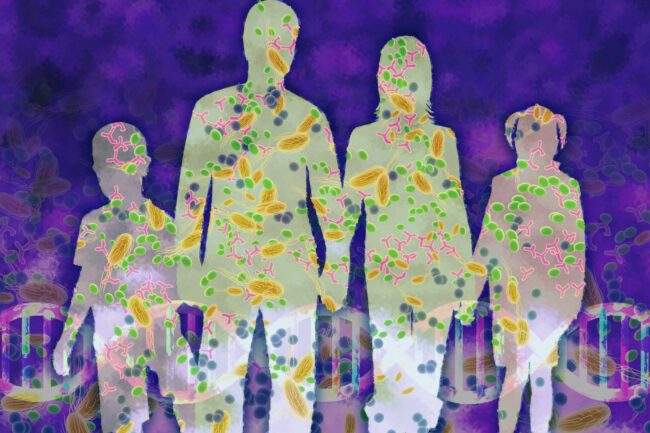From deep sea hydrothermal vents, to the frozen ice of the poles; in soils, waters, and on rocks, there is an invisible world around us…and inside us. This secret world is that of microbes. Don’t worry, having microbes inside you doesn’t mean that you are infected or diseased, it is absolutely normal. Microbes were the first living form to appear on Earth, and most other complex organisms (animals, plants and insects) have evolved to live in symbiosis with them. The vast community of microbes, encompassing bacteria, fungi and viruses to name a few, are known as microbiota. Some studies suggest that the number of cells in our microbiota is superior to the number of human cells in our body with a factor of 1.3:1 1. In other words, in term of cell number, we are 57% microbes and 43% humans! What this really means is that we are ecosystems rather than individuals. Microbes inhabit us, but they also pay their rent: they protect us from harmful microbes, help us to digest our food and synthesise vitamins and hormones. Human gut microbiota is so important that it is sometimes considered to be a separate organ! This organ is highly dynamic and changes over time, for example when we change our diet. Disruption of gut microbiota has actually been linked to diseases such as obesity, depression and cancer 2 3 4.
Unfortunately, microbes still have a bad reputation and because of this they are feared and hunted. If you go to your local supermarket, you will see aisles of cleaning products that promise to protect you by eliminating 99.9% of bacteria. Although necessary in some cases, these products can have adverse effects: there is some evidence to suggest that children growing up in “ultra clean” environments are more likely to develop allergies. It is believed that if the immune system has not been “trained” by coming into contact with enough microbes, it might over-respond to non-harmful substances. Another problem that directly comes from our misunderstanding of the microbial world is our use of antibiotics. They are widely used in agriculture and in medicine but studies show that their overuse can result in an increase in microbial resistance. Consequently, this can make harmful microbes even more dangerous and difficult to treat. On top of this, antibiotics don’t just target pathogens, they can also disturb the microbiota. Antibiotics are indispensable to treat some diseases but, it is argued, their usage should be subjected to stricter regulations.
Microbes also play a vital role in natural ecosystems. They are the driving forces of all geochemical cycles and are at the basis of all food webs. Human activities result in major modifications of the ecosystem by releasing different kinds of pollutants (including hydrocarbons, nutrients, and pharmaceuticals). Microbes often interact with these pollutants via biochemical transformations, and these transformations can result in a more toxic compound. For example, in certain conditions, mercury can be transformed into methylmercury, a compound which can accumulate in living organisms more readily as it is soluble in fat. This is particularly concerning, as in 1965, it was discovered that methylmercury was the cause of widespread, severe neurological disease in Minamata, Japan 5. Wastewater released from a chemical plant was found to contain methylmercury, some of which may have been a product of biochemical transformation. This then bioaccumulated within fish, a major component of the local diet. Over a period of 36 years, 2,265 people suffered from mercury poisoning by eating seafood containing this toxic compound.
In other cases, microbes can actually be used to eliminate pollution. This process is called bioremediation. Microbes are widely used for the remediation of soils contaminated with oil, and in wastewater treatment plants (WWTP) for the removal of excess nutrients. Microbe-based remediation techniques have the double advantage of being both cheap and effective. One of the most widespread pollutants worldwide is nitrogen, an essential compound of living cells that is present in DNA and proteins. Nitrogen is naturally present in the environment, and the transformation of nitrogen species is, to a great extent, controlled by microbial activities. The nitrogen cycle is important ecologically and directly affects primary production (the process by which plants create their own food from sunlight). All life on Earth relies on primary production, either directly or indirectly, so understanding the factors influencing microbial processes in natural systems is imperative. Together with phosphorus, nitrogen supports the growth of algae, plants and phytoplankton, which form the basis of the food chain. However, there can be too much of a good thing. As such, if nitrogen becomes too highly concentrated in part of the ecosystem it can actually be considered a pollutant. The use of nitrogen-containing fertilisers in agriculture, and ineffective WWTPs, can result in an increase in the amount of nitrogen entering marine systems via rivers and estuaries. As it is a nutrient, this increased loading of nitrogen is responsible for algal blooms. These blooms lead to the creation of anoxic water zones where the concentration of dissolved oxygen is too low to support the normal ecosystem. These zones are responsible for the mass death of fish and other marine animals.
The role that the microbiota play is immeasurable and the examples above touch only the surface. As technology advances, researchers have developed techniques more commonly associated with forensics to extract and read microbial DNA. This has allowed them to determine more clearly “who” is living in both our own bodies and in the wider ecosystems. However, despite these new technologies the microbial world remains partially unexplored and still misunderstood. By developing a greater understanding of this world, we may be able to better understand how to tackle the challenges faced, not only within our own bodies but across all ecosystems on Earth.
This article was specialist edited by Katrina Wesencraft and copy edited by Kirsten Woollcott.
References
- https://www.nature.com/news/scientists-bust-myth-that-our-bodies-have-more-bacteria-than-human-cells-1.19136
- http://www.hydrotherapiegeneve.ch/wp-content/uploads/2015/03/Melancholie-microbes.pdf
- https://www.nature.com/articles/nature11552
- https://www.ncbi.nlm.nih.gov/pmc/articles/PMC5806407/
- https://www.ncbi.nlm.nih.gov/pubmed/7734058

